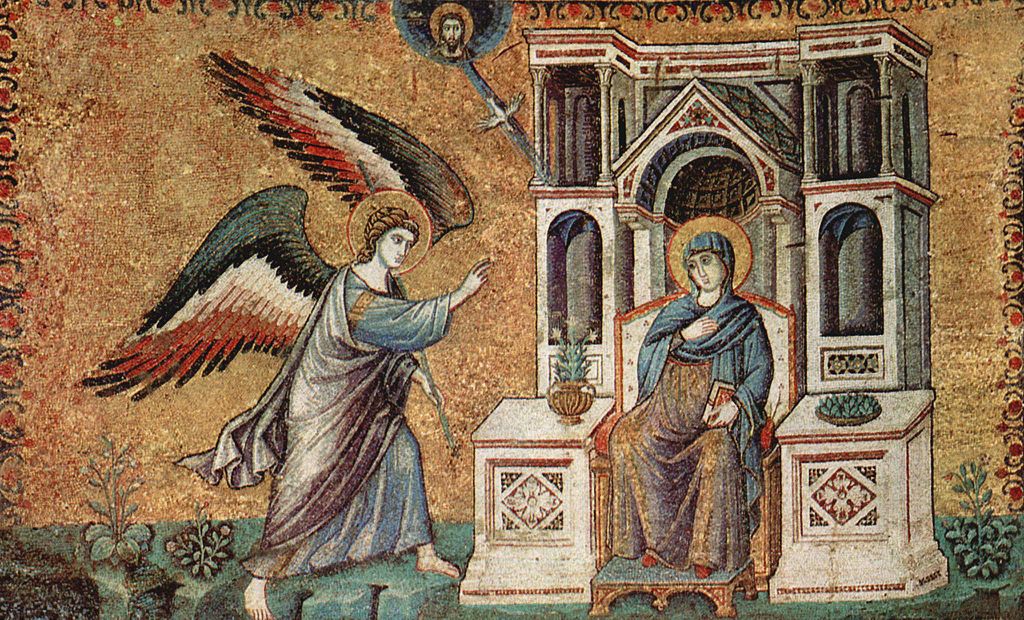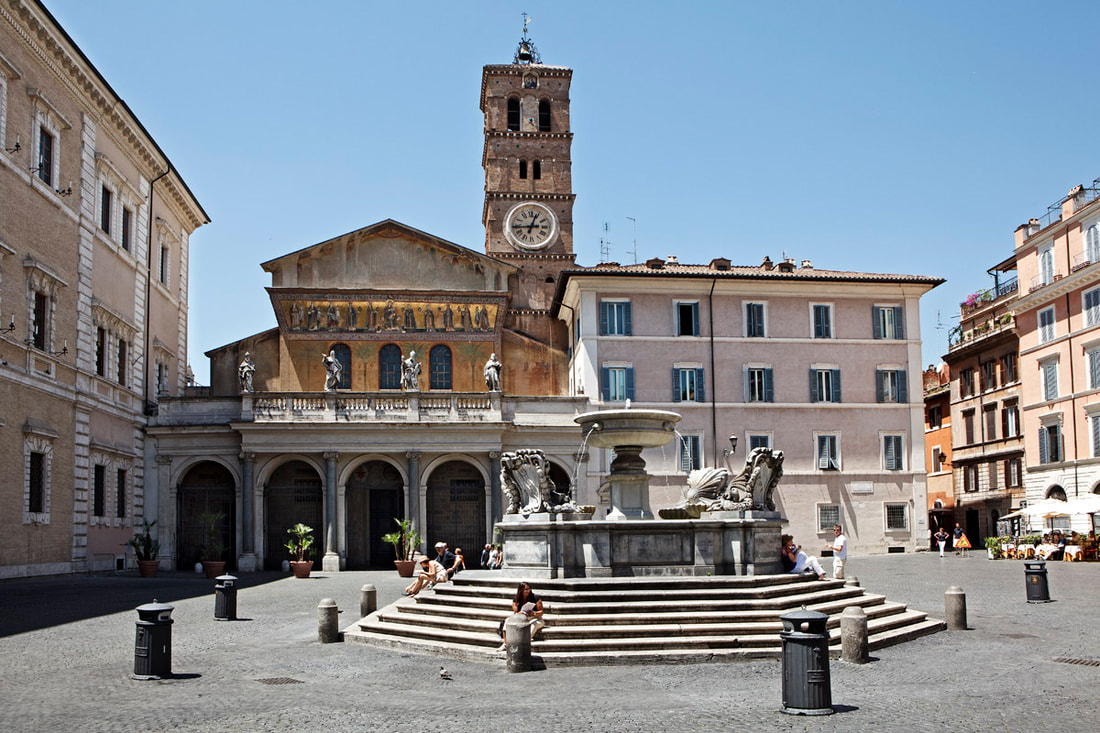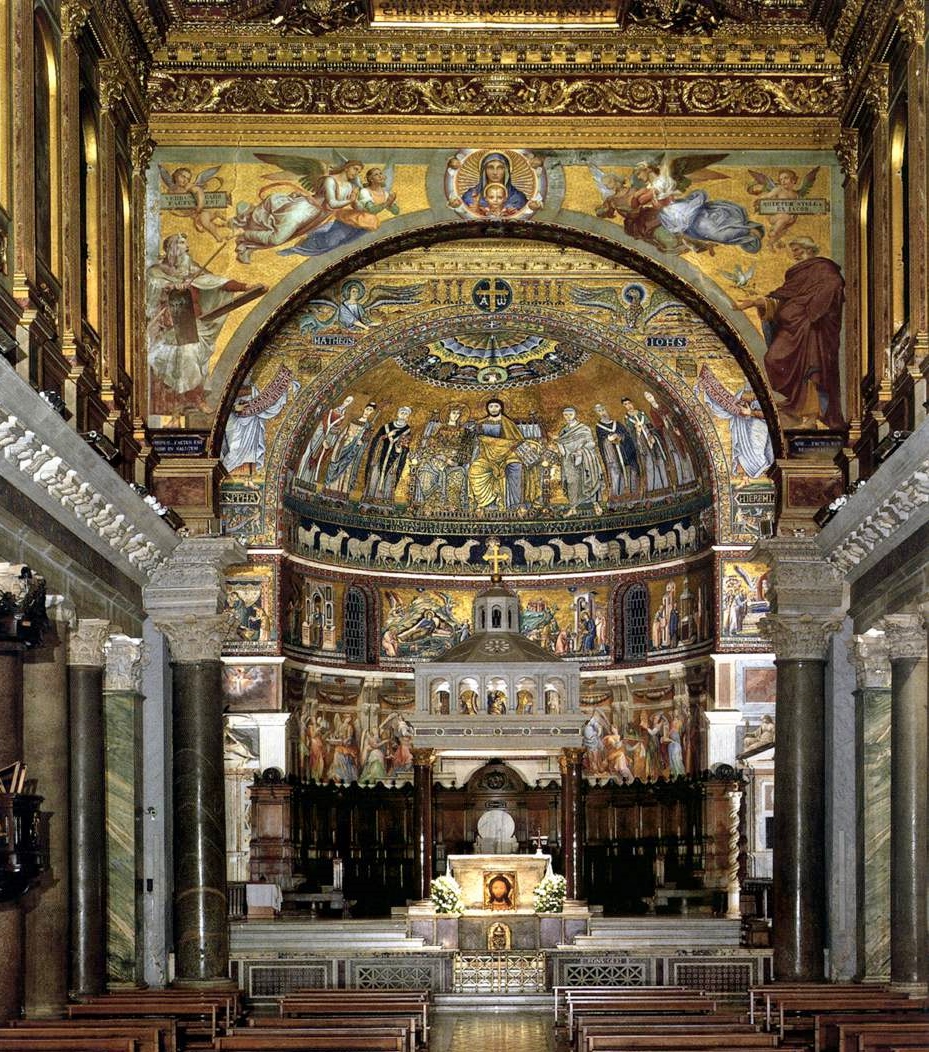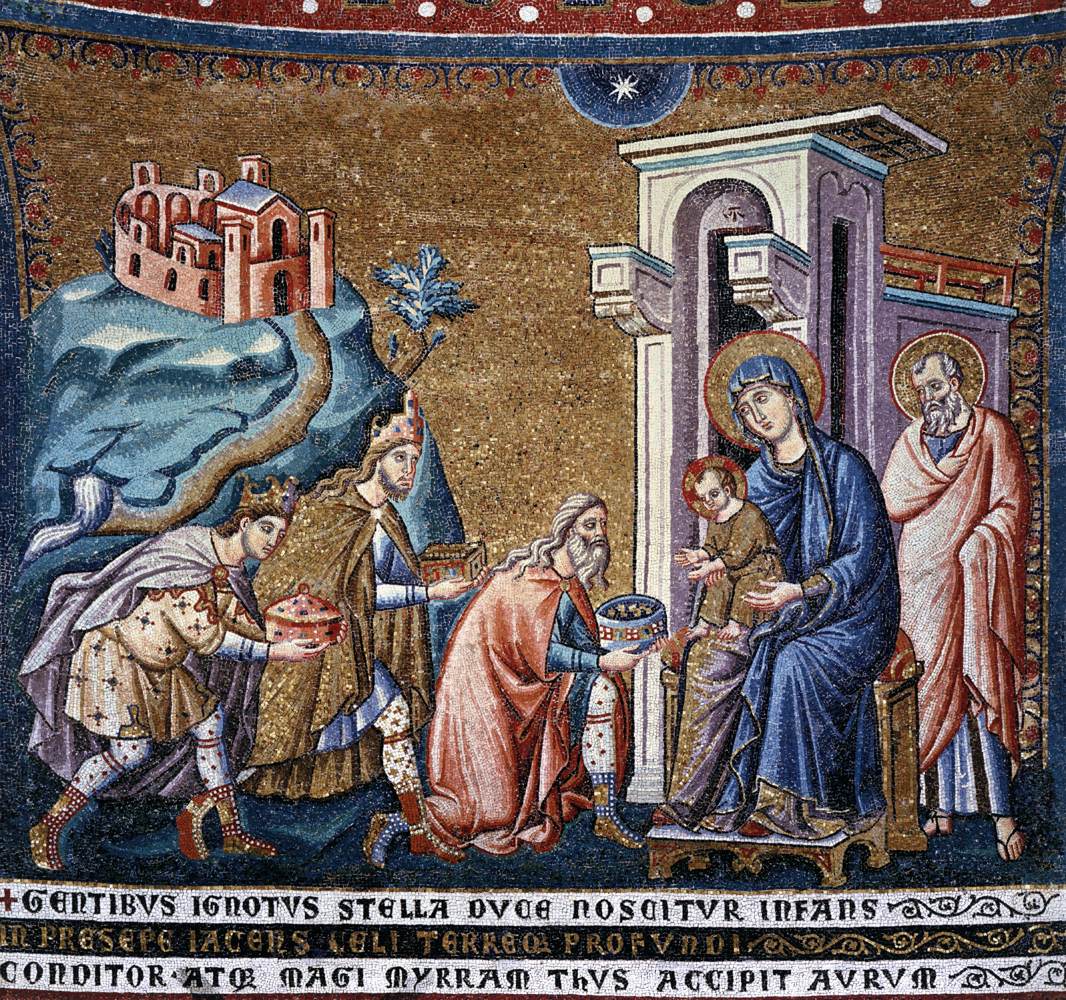According to an early Christian legend, in 38 BCE oil gushed from the ground in the Trastevere (beyond the Tiber) district of Rome. Some early Christians thought this event was the annunciation of Christ’s birth. A second legend states that the oil gushed from the ground on the night Jesus was born. Roman Emperor Constantine made the Roman Empire Christian in 312 CE, and he began construction of Christian churches. St Jerome (342-420) wrote that people in Trastevere believed the oil spring was a sign of God soon coming into the world. The spring became a meeting place for Roman converts to Christianity. In the 4th Century, Pope Callistus I began the building of Santa Maria in Fons Olei (oil spring). It was completed by Pope Julius I in 340, and it was one of the first Roman churches dedicated to the Virgin Mary. Pope Innocent II (1130-1143) reconstructed the church and named it Santa Maria in Trastevere. The octagonal fountain in the center of the piazza was originally designed by Bramante, the architect of the new St. Peter’s (1506).
To decorate the enlarged Santa Maria in Trastevere, Pietro Cavallini (1259-1330), an Italian painter and mosaic artist, was commissioned to create mosaics depicting the “Life of the Virgin” in the apse. Very little is known about Cavallini personally, but his work was praised for its technical skill and human qualities.
In the mosaic at the top of the apse, Christ has raised up Mary to be the Queen of Heaven, and they sit enthroned together. Below, twelve white sheep, representing Christ the Good Shepherd’s flock, walk toward the Lamb of God, identified by the large gold halo. Cavallini’s scenes of the “Life of the Virgin” are below the sheep. The series begins with Her birth at the far left, and end with Her death the far right. The Christmas story begins with the second panel, ‘’Annunciation.’’
Following the Byzantine tradition, the “Annunciation” takes place against the golden sky of Heaven. Cavallini depicts a bare-footed Angel Gabriel walking vigorously toward Mary, his multicolored wings stretched behind him. Gabriel’s right hand is raised in greeting Mary. Wearing a gold gown with a blue robe, Mary has been reading, and looks up with surprise. The face of God appears in the blue Heaven. The white dove represents the Holy Spirit. Three green plants grow are symbolic of the presence of the Trinity. The vase containing three white lilies are symbols Mary’s joy at Christ’s birth, Mary’s sorrow at Christ’s death, and Mary’s glory as she is taken to heaven. The dish of green figs is symbolic of Mary’s divine fertility.
Cavallini was able to depict credible facial expressions and to give his subjects reasonable body proportions for his time. He also demonstrated his skill depicting an elaborate architectural structure to hold Mary’s chair. Artists’ ability to create three-dimensional images was severely limited at the time. Cavallini clearly had been tackling the technique, and the “Annunciation” shows what he accomplished.
Cavallini followed the Byzantine tradition of placing the “Nativity” in a cave, rather than in a stable. The Greek Byzantine artists chose the cave because caves were used for the stables in the east. The eight-pointed Star of Resurrection appears in the blue globe of Heaven. In this setting it is called the Star of Bethlehem. Having given birth, Mary lies beside Jesus. His halo represents the Trinity. The ox and the ass look at the Child, and He looks back at them. Joseph is portrayed in the classical pose used to represent contemplation.
Above the cave, two angels lean in to witness the scene. A single angel announces the birth to a shepherd, showing him a banner containing the words, “I bring you great joy.” The shepherd’s flock and dog are placed in the foreground. The sheep drink from a stream of water. A shepherd boy pipes a tune. The figures are nestled in a pocket of earth.
A small yellow building labeled Taberna Meritoria refers to the location of the oil spring and the eventual site of Santa Maria in Trastevere. In the 3rd Century, early Christians asked Emperor Alexander Severus (reign 222-235) if they could build a retirement home for veterans on the site. Cavallini depicted black oil running from the front of the structure.
The shepherd boy, cheeks puffed and eyes wide from blowing, plays his horn for the sheep. They seem to listen intently and perhaps smile. Cavallini achieves a three-dimensional image by variations of skin tones on the boy’s face, neck, arms, and legs. His fingers are in the correct position for playing the flute. His calf muscles are delineated. His brown boots and purple tunic also have dimension. The white coats of the sheep are shadowed with gray, achieving a shaggy look. A small lamb and ewe, nuzzle each other. Cavallini’s skill is evident.
Mary, in her familiar blue cloak, holds Jesus on her lap, although He is suspended not sitting. Still learning to depict human anatomy, Cavallini has not been able to make Mary’s hand support the Child. Unlike other twelve-day old babies, Jesus typically was depicted as physically capable of responding to others. He reaches out His arms and recognizes the Magi. The eldest of the three, with a gray beard and hair, kneels to present his offering of gold. The middle-aged one, dressed in a gold robe, presents a chest of frankincense. The youngest bows and offers a container of myrrh. All three are elaborately dressed, especially in decorative white leggings and jeweled boots. Cavallini has depicted their dignity and their respect.
Twelve days have passed since the Nativity, and Cavallini has taken the opportunity to place the Holy Family in an architectural structure in the scene, rather than in the cave. The eight-pointed star of Bethlehem appears above. The white marble structure has a Roman round arch doorway with two ledges that project from it. Cavallini has attempted to depict the room behind the door. He was successful in making the façade of the structure three-dimensional. However, all his figures are too large to enter the building. Joseph looks on quietly beside the structure. At the upper left, the walled town of Bethlehem sits on the top of a mountain. The brown road the Magi traveled from the city to see the Child is depicted. Fresh water springs forth at the lower end of the road.
Cavallini’s commission at Santa Maria in Trastevere was significant because he was one of the most respected artists of his time. Pope Boniface VIII had designated the year1300 to be the first Jubilee of the Church. The churches to be visited by millions of pilgrims were St. Peter’s and St. Paul’s in Rome. Santa Maria in Trastevere was added specifically to include a church dedicated to Mary. Cavallini’s advances in naturalism and perspective influenced artists for decades. Despite his prestige, Cavallini signed his works modestly pictor romanus (Roman painter).
Beverly Hall Smith was a professor of art history for 40 years. Since retiring with her husband Kurt to Chestertown in 2014, she has taught art history classes at WC-ALL. She is also an artist whose work is sometimes in exhibitions at Chestertown RiverArts and she paints sets for the Garfield Center for the Arts.









Deirdre LaMotte says
What a fabulous piece! I adore mosaics and will plan to visit
Santa Maria on my next trip to Rome.
Thanks so much.